Video Essay:
Research and Reflection
Public toilets are one of the most accessible spaces in Hong Kong. Shopping malls, MTRs are mostly equipped with public toilets providing for resolving the necessity of the populace (Lynn, 2022).
As a realm of contract and exchange between strangers, public toilets are typically classified as public space (Hampton, 2010). However, a deeper examination of its function, design, and people’s feelings reveals that it is more akin to a period of private space for everyone who passes through the public space. First, it serves only the individual as a subjective realm of the body, that renders it a private space (Sommer, 1969). In addition, this enclosed space is defined as having a private core since it is under the control of an individual in a personal capacity, is not subject to public observation, and is not under the control of an official or the state (Madanipour, 2003). In addition, it meets the criteria established by Bellamy (2017) for determining whether a location is private, which are secrecy (information known about an individual), anonymity (attention paid to an individual), and solitude (physical access to an individual).
Based on its complex essence, the title of the passage employs a strong sense of contrast in constructing both the concept of “public toilet” and the concept “private city,” with “public” and “city” serving as a public concept in contrast to the private concept of “private” and “toilet.” [See figure 1]
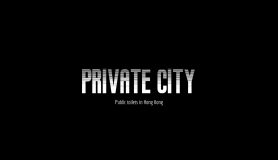
Figure 1
Starting with research into the function of public restrooms, I figure out that it is complicated because of the multiple ways that people use it and their conflicting perspectives on the public and private purposes of this unique area. After careful research and effective field trip, I discovered some unreasonable but unavoidable designs for public restrooms which may lead to privacy leakage and break the boundary of privacy. I also gained a deeper understanding of the architectural elements including its location in public areas and people’s natural behavior conducted in the space that influence how they feel in toilets. This video is intended to highlight the importance of privacy, in contrast to the public’s perception of this ostensibly public place, by revealing the distinctive qualities and complexity of public restrooms. This is coupled with my personal experience, in which the door was pushed open while I was seated on the toilet, making me feel terrified of being viewed and observed.
Video Brief and Techniques
The general tone of the video shifts from private to public. Beginning with locking the door and introducing the functions by which people conduct personal affairs in public toilets, we can conclude that public toilets serve multiple purposes [See figure 2]. Defecation and urination are the final and most vital functions. This contributes to emphasizing the theme, specifically the experience of privacy breach. Following the shots describing the potential, inevitable design flaws [See figure 3] in public toilets that may lead to privacy leakage is a continuous real scene capture of the structure of most public toilets, in which the public and private areas are separated by a single wall (See figure 4). It concludes with repeated actions of unlocking the door in public view.
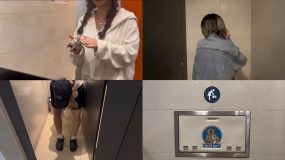 Figure 2
Figure 2

Figure 3
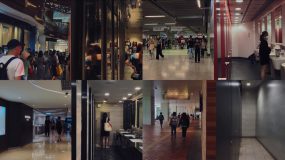
Figure 4
Another objective during the research phase is to discover more filming methods to enhance the viewing experience. Generally, the video is in dark tone [see figure 5] hinting at the mysterious role of public toilets in people’s daily life and the filter helps to unify the tone of the film, enhances the realism of the moving scenes (Kalmus, 1935). And the handheld shots create a greater sense of immediacy for the audience while arouse trembling atmosphere (Brashear, 2022). The one-minute long take [see figure 6] is used for recording the main function of the public toilets and smoothly draw audience attention into the space via continuous look at the setting and moving parts (New York Film Academy, 2018). After this, a flashback is used for flashforward to an event and tells the viewers that a completely inverse plot is going to happen (Field, 2020). Apart from that, the most time-consuming shot using the effect of montage appears to show the experience of the door being pushed open when one is seated in the toilet [see figure 7]. This shot combines the gaze of the person in the toilet, with the view from outside the toilet trying to push the door open, to fully depict the entire process of the door being pushed open. The strong light at the end [see figure 8] is a metaphor for the gaze to show the intense discomfort of privacy being leaked. The shots are like a juxtaposition of causal narrative combinations, a parallel montage that explains the causes and consequences of the door being pushed open which creates a suspensable and dramatic atmosphere (Nie, 2011). Finally, opening action on the door together with and matching with the closing beginning actions, [see figure 9] also resembles the general going of the video, reveals on the private and public nature of the space.
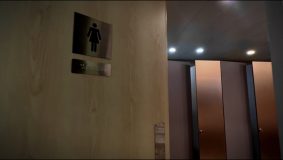
Figure 5
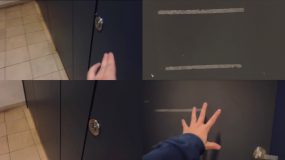
Figure 6
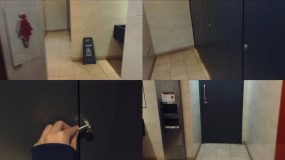
Figure 7
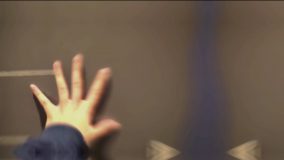
Figure 8
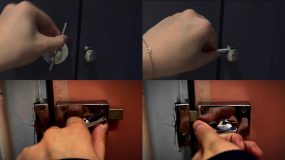
Figure 9
Director: Ouyang Yuning (3036100870)
Credits: Yan Kexin, Deng shuyuan
Sites selection – Public toilets in:
1. SOGO, 555 Hennessy Rd, Causeway Bay
2. Harbour City, Shop OT215K, 2/F, Ocean Terminal, 3-27 Canton Rd, Tsim Sha Tsui
3. The university of Hong Kong
4. Central Station
5. K11 MUSEA
Bibliography
Bellamy, R. (2017). The Rule of Law and the Separation of Powers. Routledge.
Brashear, L. (2022, July 25). LibGuides: Film and Media Studies: Camera Movement. Eac.libguides.com. https://eac.libguides.com/c.php?g=723550&p=5311207#:~:text=Handheld
Field, S. (2020, November 14). The Use of Flashbacks in Movies. Writers Store. https://writersstore.com/blogs/news/the-use-of-flashbacks-in-movies#:~:text=You%20can%20use%20flashbacks%20for
Hampton, K. N., Livio, O., & Sessions Goulet, L. (2010). The Social Life of Wireless Urban Spaces: Internet Use, Social Networks, and the Public Realm. Journal of Communication, 60(4), 701–722. https://doi.org/10.1111/j.1460-2466.2010.01510.x
Kalmus, N. (1935). Color consciousness.
Madanipour, A. (2003). Public and private spaces of the city. Routledge.
Lynn, G. (2022, December 6). Hidden Hong Kong: A history of Hong Kong’s public bathrooms. Localiiz. https://www.localiiz.com/post/culture-history-public-bathrooms-hong-kong#:~:text=And%20when%20those%20are%20out
New York Film Academy. (2018, January 19). The Art of the Long Take | Student Resources. The Art of the Long Take. https://www.nyfa.edu/student-resources/art-long-take/#:~:text=A%20common%20one%20is%20for
Nie,X. (2011). 影视剪辑 = Montage (Di 1 ban.ed.). Shanghai : Fu dan ta xue chu ban she
Sommer, R. (1969). Personal Space. Englewood Cliffs, N.J. : Prentice-Hall.
Ouyang Yuning (3036100870)
I loved the creativity of the video and the use of first-person POV angles to create a pressing atmosphere when you need the bathroom. I also adored the creativity concerning the use of dark comedic elements.
But frankly, the video lacks an in-depth discussion of the function of public toilets, or its role in the city. I was expecting to hear more about the societal functions of a public toilet and how the government has revamped public toilets to cater to the increasing needs of the public, such as breastfeeding facilities.
Another pitfall of the video was the lack of voice recording, I think that the descriptions on the screen alone were not able to convey your message and often led to a bland scene, therefore adding human touch by voice would be a good option.
Last but not least, sometimes the shots were confusing, as they seemed to be leading to nowhere, you should better switch between different shots to avoid long shots, which may mislead the audience. But overall the video still effectively compares different public toilets within Hong Kong. Good Job!
Your video investigated the privacy of public bathrooms and demonstrated how privacy can sometimes be compromised in these spaces. I appreciate your approach in investigation, however some explanation of the significance of your conclusion and more analytical elaboration in your text will help solidify your position. Perhaps bringing in ideas of surveillance culture will help support your argument.